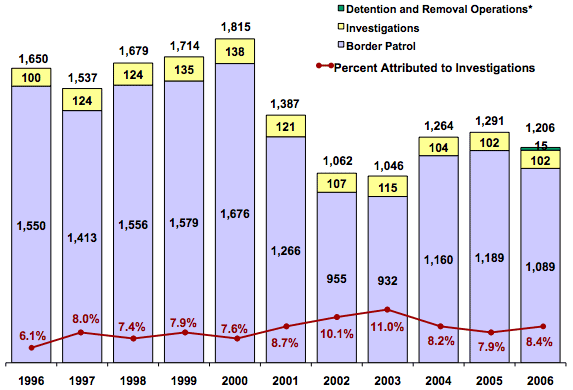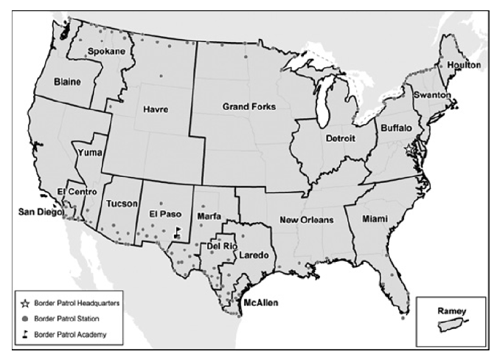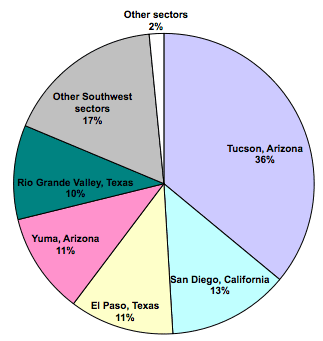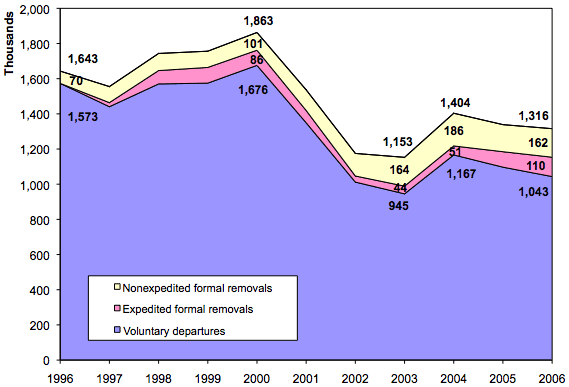Immigration Enforcement in the United States in 2006
Source Spotlights are often updated as new data become available. Please click here to find the most recent version of this Spotlight.
Drawing from the Yearbook of Immigration Statistics, published by the Department of Homeland Security's (DHS) Office of Immigration Statistics (OIS), this Spotlight provides data on apprehensions, detentions, and removals of unauthorized noncitizens in the United States as of 2006 (OIS has released the 2007 data tables only).
Editor's note: In the "removals" section, the article originally stated there were 1.3 million removals in 2006. The 1.3 million number includes voluntary departures, which are not the same as formal removals. There were 1 million voluntary departures and 272,389 formal removals in 2006. Also, the article stated total removals decreased 2 percent between 2005 and 2006. More accurately, the number of voluntary departures and total removals declined by 2 percent. These statements, along with the title of Figure 3, have been corrected. We sincerely regret the errors.
Click on the bullet points below for more information:
Background
- Immigration enforcement entails locating, arresting, detaining, and removing non-U.S. citizens (including lawful permanent residents) in violation of immigration laws.
- Immigration enforcement activities are carried out by Customs and Border Protection (CBP) and Immigration and Customs Enforcement (ICE).
- Immigration and Customs Enforcement may train state and local law enforcement officers to perform immigration law enforcement functions.
- The Border Patrol is responsible for enforcing border areas between legal ports of entry.
- Inspectors verify admissibility of entrants to the United States at official ports of entry.
- Investigators apprehend unauthorized immigrants in the interior of the United States.
- Within ICE, the Special Agent-in-Charge (SAC) offices are responsible for administering and managing all enforcement activities within the office's geographic jurisdiction.
- Detention and removal officers are responsible for the custody and tracking of individuals in removal proceedings.
Apprehensions
- Immigrants are apprehended (arrested) when found to be in violation of immigration laws.
- In 2006, DHS immigration officials made over 1.2 million apprehensions.
- Border Patrol apprehensions accounted for about 90 percent of all apprehensions in 2006.
- Of the Border Patrol apprehensions, 98 percent occurred along the Southwest border.
- Apprehensions along the Southwest border decreased 8 percent between 2005 and 2006.
- The Tucson sector accounted for more Border Patrol apprehensions than any other sector in 2006.
- Mexican citizens accounted for 88 percent of all apprehensions in 2006.
- ICE located 101,854 deportable immigrants in 2006 through investigations.
|
Special Note
|
||
|
Detentions
- Individuals who are apprehended and not released from custody are kept in detention facilities.
- In 2006, immigration officials detained over 250,000 individuals.
- Nationals from Mexico, El Salvador, Honduras, and Guatemala accounted for three of every five bed days in 2006.
- ICE uses several kinds of detention facilities to house people detained for immigration-related violations.
- On average, about two-thirds of ICE detainees are held in state and local jails.
Removals
- Removal proceedings are usually conducted during immigration hearings that involve judges from the Executive Office of Immigration Review (EOIR).
- The two basic types of removal are voluntary departure and formal removal.
- An expedited removal is a type of formal removal ordered by an inspector at the time of attempted entry.
- There were 1 million voluntary departures and over 272,000 formal removals in 2006.
- Voluntary departures and formal removals decreased 2 percent between 2005 and 2006 mainly due to a decline in the number of voluntary departures.
- Expedited removals accounted for two of every five formal removals in 2006.
- Mexican citizens accounted for nearly seven of every 10 formal removals in 2006.
- Almost all expedited removals occurred at three offices in the Southwest.
Background
Immigration enforcement entails locating, arresting, detaining, and removing non-U.S. citizens (including lawful permanent residents) in violation of immigration laws.
Immigration enforcement entails locating, arresting, detaining, and removing non-U.S. citizens (including lawful permanent residents) who violate the Immigration and Nationality Act (INA) of 1952, as well as those who attempt illegal entry, enter without authorization, or those who enter legally but later lose their legal status.
The Illegal Immigration Reform and Immigrant Responsibility Act (IIRIRA) of 1996, which amended INA, dramatically changed previous enforcement procedures, categories, and definitions, especially those pertaining to detention and removals. For information on INA amendments, visit the U.S. Citizenship and Immigration Services (USCIS) website.
Immigration enforcement activities are carried out by Customs and Border Protection (CBP) and Immigration and Customs Enforcement (ICE).
Since the creation of the Department of Homeland Security (DHS) in 2003, two bureaus within DHS have been responsible for immigration enforcement: Customs and Border Protection (CBP) and Immigration and Customs Enforcement (ICE).
Most immigration enforcement activities fall under four main categories: border patrol, inspections, investigations, and detention and removal. CBP, which oversees enforcement at and between points of entry, handles border patrol and inspections.
ICE is responsible for enforcing immigration laws within the interior of the United States. Investigations are a part of ICE operations. While the Office of Detention and Removal (DRO) is officially part of ICE, services are also contracted out to CBP.
Immigration and Customs Enforcement may train state and local law enforcement officers to perform immigration law enforcement functions.
Section 287(g) of IIRIRA authorizes DHS to enter into agreements with state and local law enforcement agencies, allowing trained officers to perform immigration law enforcement functions under the supervision of an ICE officer.
In order to deputize state and local law enforcement officers, ICE must sign a memorandum of understanding with the head of the local agency and the governor of the state.
As of September 2008, DHS maintained 63 active memoranda of understanding and had provided 287(g) training and certification to 840 officers. DHS credits the program with identifying more than 70,000 individuals (since January 2006) who are suspected of being unauthorized immigrants.
For more information on 287(g) agreements, visit the Immigration and Customs Enforcement website.
The Border Patrol is responsible for enforcing border areas between legal ports of entry.
CBP Border Patrol officers are responsible for enforcing 8,000 miles of U.S. land and water boundaries between legal ports of entry (designated points where immigration officials can regulate entry). The goal of the Border Patrol is to maintain a presence along border areas in order to prevent individuals, such as criminals and unauthorized migrants, from entering U.S. territory outside official ports.
Inspectors verify admissibility of entrants to the United States at official ports of entry.
CBP inspectors verify admissibility of entrants to the United States at official ports of entry, such as a land-border crossing or airport. If an individual is deemed inadmissible, the inspector has the authority to allow a person to withdraw his or her application for entry, refer the case to a formal removal hearing, or, in some instances, order removal himself under a process called "expedited removal" (more on expedited removal here).
Investigators apprehend unauthorized immigrants in the interior of the United States.
ICE investigators apprehend unauthorized immigrants in the interior of the United States through formal investigations similar to those of other law enforcement agencies. Investigators often work in task force teams.
The five major categories of investigations are criminal, worksite enforcement (employment of unauthorized workers), fraud, smuggling (of unauthorized migrants), and investigations of those who entered without inspection or lost their legal status.
Within ICE, the Special Agent-in-Charge (SAC) offices are responsible for administering and managing all enforcement activities within the office's geographic jurisdiction.
SACs develop, coordinate, and implement enforcement strategies that are in line with national policies and procedures. SAC offices have considerable discretion in tailoring immigration enforcement strategies — including investigations — for specific geographic regions. There are 26 ICE Special Agent in Charge (SAC) jurisdictions (see Map 1).
 |
Map 1. Immigration and Customs Enforcement Special Agent-in-Charge Jurisdictions (PDF) Notes: The map contains the following acronyms for various offices: DSAC: Deputy Special Agent-in-Charge RAC: Resident Agent-in-Charge ASAC: Assistant Special Agent-in-Charge RA: Resident Agent Source: Department of Homeland Security, U.S. Immigration and Customs Enforcement |
Please note: Due to compatibility issues, you may need to download the map to your computer in order for it to load properly.
Detention and removal officers are responsible for the custody and tracking of individuals in removal proceedings.
ICE detention and removal officers are responsible for the custody and tracking of individuals in removal proceedings. For example, they ensure the individual's basic needs are provided for, removal procedures are carried out appropriately, and detainees are delivered to the proper authorities in their home country.
View the charts depicting trends in immigration enforcement spending (for Border Patrol, interior investigations, detention and removal) between 1985 and 2002 here.
Apprehensions
Immigrants are apprehended (arrested) when found to be in violation of immigration laws.
Immigrants are apprehended when found to be in violation of immigration laws, when attempting illegal entry, or when found to have overstayed or violated conditions of their immigration status. Violators are apprehended through Border Patrol or investigation activities.
In 2006, DHS immigration officials made over 1.2 million apprehensions.
According to DHS, immigration officials made 1,206,457 apprehensions in 2006, 6.6 percent less than in 2005. The annual number of apprehensions has stayed relatively constant since 1996, ranging from 1.81 million in 2000 to 1.05 million in 2003 (see Figure 1).
Note: Apprehensions are events, not individuals. In other words, the same individual can be apprehended more than once.
|
|
||
|
Border Patrol apprehensions accounted for about 90 percent of all apprehensions in 2006.
The Border Patrol made 90 percent (1,089,136) of all apprehensions in 2006, while investigations in the interior were responsible for only 8 percent (101,854) of apprehensions.
DRO's National Fugitive Operations Program (NFOP) made the remaining 1 percent (15,467) of apprehensions. NFOP identifies, locates, and removes fugitive immigrants, placing a premium on immigrants who pose a threat to national security or community safety. Fugitive operations teams participate in various federal, state, and local task forces and work closely with U.S. Citizenship and Immigration Services (USCIS) and the U.S. Department of Justice's Bureau of Prisons (BOP), among other agencies.
For more information on NFPO, visit the ICE Office of Detentions and Removal website.
Of the Border Patrol apprehensions, 98 percent occurred along the Southwest border.
There are a total of 20 Border Patrol sectors along both the northern and southern borders. Nine of these sectors are along the Southwest border: two in Arizona, two in California, and five in Texas (see Map 2). Of the Border Patrol apprehensions, 98 percent (1,072,018) occurred along the Southwest border.
|
Map 2. Border Patrol Sectors
|
||
|
Apprehensions along the Southwest border decreased 8 percent between 2005 and 2006.
Apprehensions along the Southwest border decreased by 8 percent between 2005 (1,171,428) and 2006 (1,072,018).
Between 2005 and 2006, the number of apprehensions increased in two Southwest sectors: San Diego, California (12 percent, or 15,213), and El Centro, California (10 percent, or 5,743). The number of apprehensions declined in the remaining Southwest sectors: El Paso, Texas (which includes New Mexico); Laredo, Texas; Tucson, Arizona; Yuma, Arizona; Rio Grande Valley, Texas; Marfa, Texas; and Del Rio, Texas (see Table 1).
|
|
||||||||||||||||||||||||||||||||||||||||||||||||||||||||||||||||||||||||||||||||||||||||||||||||||||||
|
The Tucson sector accounted for more Border Patrol apprehensions than any other sector in 2006.
Five of the nine Southwest sectors accounted for 81 percent (885,555) of all border apprehensions. These five sectors were Tucson, Arizona; San Diego, California; El Paso, Texas; Yuma, Arizona; and Rio Grande Valley, Texas.
The Tucson sector accounted for 36 percent (392,104) of the 1.1 million Border Patrol apprehensions in 2006, followed by San Diego (142,122), El Paso (122,261), Yuma (118,537), and Rio Grande Valley (110,531) (see Figure 2).
|
|
||
|
Mexican citizens accounted for 88 percent of all apprehensions in 2006.
Mexican citizens accounted for the majority of apprehensions in 2006 with 1,057,253 (88 percent) of the 1.2 million apprehensions. Citizens of El Salvador, Honduras, and Guatemala — the next-largest three countries of origin — accounted for 4 percent (46,329), 3 percent (33,365) and 2 percent (25,135), respectively.
ICE located 101,854 deportable immigrants in 2006 through investigations.
Nearly half (49 percent, or 49,930) of the 101,854 deportable immigrants located through investigations in 2006 were attributable to six of the 26 Special Agent-in-Charge (SAC) jurisdictions: Los Angeles, California (11 percent, or 11,328); Phoenix, Arizona (10 percent, or 10,526); San Francisco, California (10 percent, or 9,893); Chicago, Illinois (8 percent, or 7,722); Denver, Colorado (5 percent, or 5,373); and Seattle, Washington (5 percent, or 5,088).
Detentions
Individuals who are apprehended and not released from custody are kept in detention facilities.
ICE detains individuals who are apprehended and not released from custody. Since the implementation of the Illegal Immigration Reform and Immigrant Responsibility Act (IIRIRA), in 1997, detention has become mandatory for cases classified as "criminal."
In some instances, individuals may be detained indefinitely because they are considered a threat to national security or because their country of origin will not accept responsibility for them. Persons appealing a removal decision or applying for asylum status may also be detained until their cases are settled.
In 2006, immigration officials detained over 250,000 individuals.
Immigration officials detained about 256,842 individuals in 2006. The number of individuals in detention increased 8 percent from 237,667 in 2005 to 256,842 in 2006 and increased 23 percent from 209,000 in 2001.
The daily average number of detainees was 21,450 in 2006 (see Table 2).
|
|
|||||||||||||||||||||||||||||||||||||||||||||||||||||||||||||||||||||||||||||||||||||||||||||
|
|||||||||||||||||||||||||||||||||||||||||||||||||||||||||||||||||||||||||||||||||||||||||||||
Nationals from Mexico, El Salvador, Honduras, and Guatemala accounted for three of every five bed days in 2006.
Individuals from Mexico, El Salvador, Honduras, and Guatemala accounted for 59 percent of all bed days in 2006, up from 49 percent in 2005 and 39 percent in 2001. Individuals from Mexico alone accounted for 26 percent of all bed days in 2006 while Salvadorans were second with 12 percent.
ICE uses several kinds of detention facilities to house people detained for immigration-related violations.
ICE detention facilities include service processing centers (SPCs), which are owned and operated by ICE; contract detention facilities (CDFs), which are owned and operated by private-sector businesses on behalf of ICE; facilities operated by state and local government entities that contract with ICE through intergovernmental service agreements (IGSAs); and facilities operated by the Federal Bureau of Prisons and Office of Refugee Resettlement.
ICE owns and operates eight SPCs (in Florence, Arizona; El Centro, California; San Pedro, California; Miami, Florida; Batavia, New York; Aguadilla, Puerto Rico; El Paso, Texas; and Port Isabel, Texas) and contracts for seven CDFs (in San Diego, California; Denver, Colorado; Pompano Beach, Florida; Elizabeth, New Jersey; Houston, Texas; Pearsall, Texas; and Tacoma, Washington).
In addition, ICE contracts with over 350 state and local jails, which are paid through ISGAs.
On average, about two-thirds of ICE detainees are held in state and local jails.
On average, about 65 percent of ICE detainees are held in state and local jails. Of the remaining detainees, 18 percent are held in privately owned and operated contract facilities (CDFs) and 17 percent in ICE owned-and-operated facilities (SPCs).
Note: Data are based on average daily population on January 21, 2008, as reported by ICE in its inaugural semiannual report on compliance with ICE national detention standards, which was released in May 2008.
Removals
Removal proceedings are usually conducted during immigration hearings that involve judges from the Executive Office of Immigration Review (EOIR).
Removal proceedings are usually conducted during immigration hearings that involve judges from the Executive Office of Immigration Review (EOIR) under the Department of Justice (DOJ), as well as prosecutors from DHS. Individuals in proceedings may be represented by attorneys at their own expense and may also appeal the court's decision through DOJ's Board of Immigration Appeals.
Individuals seeking asylum in the United States may make an asylum claim during removal proceedings. Penalties for those who are found to violate immigration laws can include fines, jail time, and restriction of future admission.
The two basic types of removal are voluntary departure and formal removal.
Voluntary departures are most common among noncriminal cases where the Border Patrol has made the apprehension. Through voluntary departure proceedings, individuals waive their rights to a formal hearing and agree to pay removal expenses. By doing so, they can reapply for admittance without consequence.
Formal removals are most commonly decided by an immigration judge for more severe INA and criminal violations, such as illegal entry, drug smuggling, felony crimes, controlled substance violations, and prostitution/solicitation.
An expedited removal is a type of formal removal ordered by an inspector at the time of attempted entry.
An expedited removal is a type of formal removal used for those who attempt to enter with improper or fraudulent documents. An inspector orders the expedited removal; the individual is not allowed to consult legal counsel or present his claim before an immigration judge.
Any person subject to expedited removal who raises a claim for asylum — or expresses fear of removal — is given the opportunity to explain his or her fears to an asylum officer in a credible-fear interview.
There were 1 million voluntary departures and over 272,000 formal removals in 2006.
In 2006, DHS removed 1,315,770 individuals from the United States. Of all removals, 79 percent (1,043,381) were voluntary departures, 12 percent (162,242) were nonexpedited removals, and 8 percent (110,147) were expedited removals (see Figure 3).
Note: Removals are events, not individuals. In other words, the same individual can be removed more than once in the same year.
|
|
||
|
Voluntary departures and formal removals decreased 2 percent between 2005 and 2006 mainly due to a decline in the number of voluntary departures.
Voluntary departures and formal removals decreased 2 percent from 1,338,698 in 2005 to 1,315,770 in 2006. Most of this decline is due to a 5 percent drop in the number of voluntary departures (1,096,920 in 2005 to 1,043,381 in 2006).
Between 2005 and 2006, the number of expedited removals increased 25 percent, from 87,887 to 110,147, and the number of nonexpedited removals increased 5 percent from 153,891 to 162,242.
Expedited removals accounted for two of every five formal removals in 2006.
Expedited removals accounted for two of every five, or 40 percent, of formal removals in 2006. The share of expedited removals in total formal removals has increased over time. In 1997, the first year DHS reported the number, expedited removals accounted for 20 percent of all formal removals.
Mexican citizens accounted for nearly seven of every 10 formal removals in 2006.
The majority of individuals removed in 2006 where Mexican citizens (183,445 of 272,389, or 67 percent). The next-largest origin countries were Honduras (10 percent), Guatemala (7 percent), and El Salvador (4 percent).
Mexican citizens also accounted for 65 percent of expedited removals in 2006. The next-largest origin countries for expedited removals were Honduras, Guatemala, Brazil, Nicaragua, and Ecuador.
Almost all expedited removals occurred at three offices in the Southwest.
Approximately 81 percent of all expedited removals in 2006 were made in one of three Southwest offices: Phoenix, Arizona (30 percent); San Antonio, Texas (29 percent); and San Diego, California (22 percent). The expedited removals occur at both CBP-operated ports of entry and ICE Special Agent-in-Charge offices.
Sources
U.S. Department of Homeland Security, U.S. Immigration and Customs Enforcement, Office of Detention and Removal Operations. 2008. Protecting the Homeland: Semiannual Report on Compliance with ICE National Detention Standards, January-June 2007. Available online.
U.S. Department of Homeland Security, Office of Immigration Statistics. 2007. 2006 Yearbook of Immigration Statistics. Available online.






